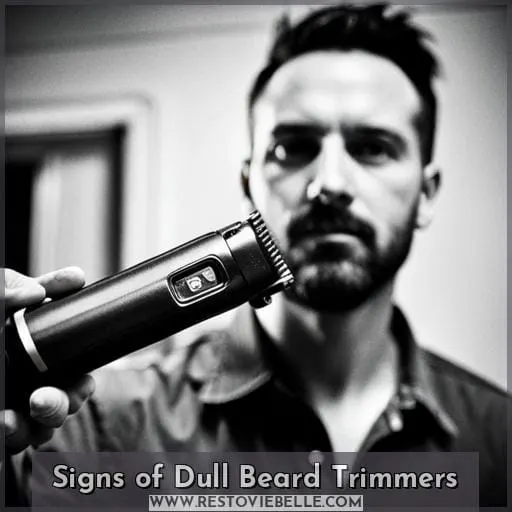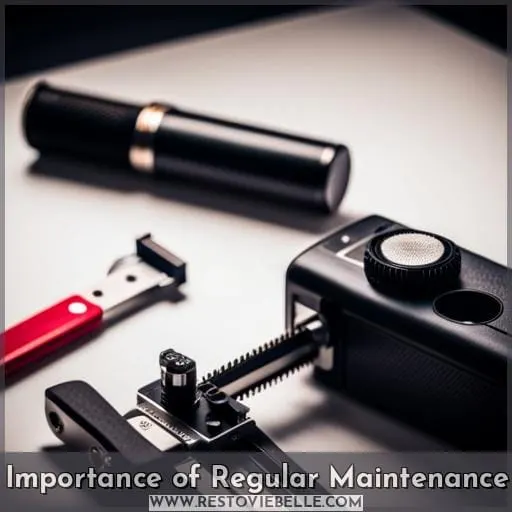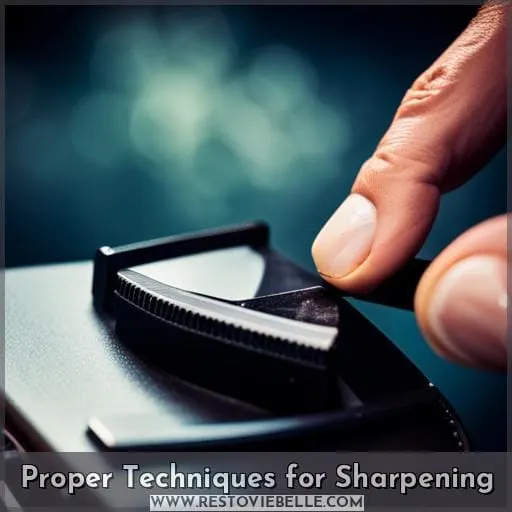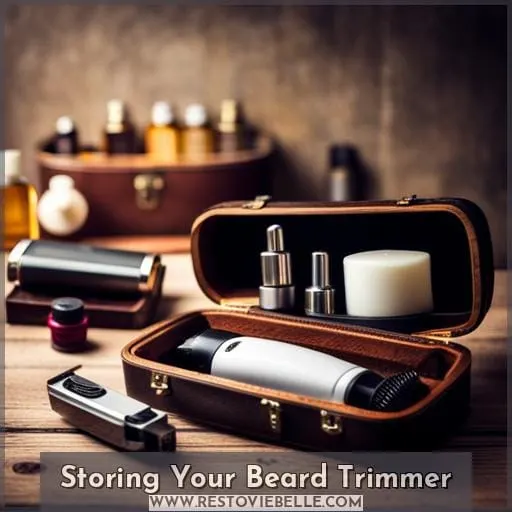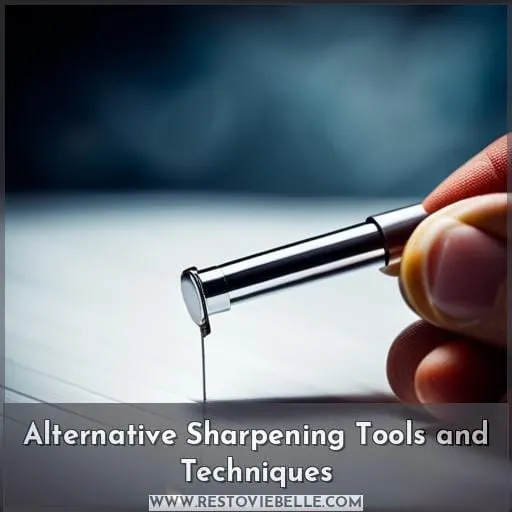This site is supported by our readers. We may earn a commission, at no cost to you, if you purchase through links.
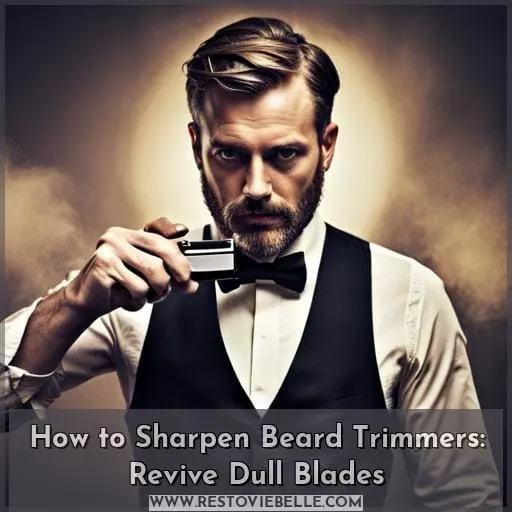 Take control of your grooming routine and revive dull blades with our guide on how to sharpen beard trimmers.
Take control of your grooming routine and revive dull blades with our guide on how to sharpen beard trimmers.
Like a master barber, you can achieve precise cuts and avoid the tugging or pulling sensation that comes with blunt blades. Regular maintenance is key, from cleaning and disinfecting to oiling the blades.
Discover when it’s time to sharpen your trimmer and learn proper techniques using stones or sandpaper.
Table Of Contents
- Key Takeaways
- Signs of Dull Beard Trimmers
- Importance of Regular Maintenance
- When to Sharpen Your Beard Trimmer
- How to Sharpen Beard Trimmers
- Proper Techniques for Sharpening
- Choosing the Right Beard Trimmer
- Storing Your Beard Trimmer
- Alternative Sharpening Tools and Techniques
- Maintenance Tips for Prolonged Sharpness
- Frequently Asked Questions (FAQs)
- Can I use sandpaper to sharpen my beard trimmer blades?
- How often should I clean and oil my beard trimmer for optimal performance?
- What are some signs that indicate my beard trimmer needs sharpening?
- Can I use a regular knife sharpening stone to sharpen my beard trimmer blades?
- Are there any specific maintenance tips to prevent my beard trimmer blades from rusting?
- Conclusion
Key Takeaways
- Remove the trimmer blades before sharpening them.
- Use a fine-grit honing stone or sandpaper to sharpen the blades.
- Inspect the blades for signs of dullness, nicks, or burrs.
- Reassemble the blades properly after sharpening.
Signs of Dull Beard Trimmers
When your beard trimmer starts to perform poorly, leaving behind uneven or jagged cuts, it may be a sign that the blades have become dull.
Another indication is when you experience a tugging or pulling sensation while trimming your beard.
Additionally, if you notice discoloration or rust on the blade surface, it’s a clear indicator that they need sharpening.
Poor Cutting Performance
If you notice a significant decrease in cutting power and find yourself making repeated passes without achieving a close shave, it’s likely that your beard trimmer’s blades have become dull.
Dull blades can result in poor cutting performance, causing uneven cuts and leaving behind a tugging sensation during shaving.
Additionally, rust on the blade can further contribute to the deterioration of its performance.
To resolve these issues, sharpening your trimmer blades is necessary to restore their sharpness and ensure optimal trimming results.
Tugging or Pulling Sensation
If you experience a tugging or pulling sensation while trimming your beard, it’s a clear indication that your beard trimmer blades are dull.
- Regularly clean and maintain your trimmer blades to prevent build-up of hair and debris.
- Oil the blades before each use for smoother operation.
- Sharpen the blades periodically using a sharpening stone or sandpaper.
- Consider replacing the blades if they can’t be effectively sharpened.
By following these steps, you can prevent tugging or pulling sensations while achieving a clean shave with ease.
Discoloration or Rust on Blade
If you notice discoloration or rust on the blade of your beard trimmer, it’s a clear sign that the blades are dull and in need of sharpening.
Rust can accumulate on the blades due to moisture exposure or improper maintenance.
To remove rust from your beard trimmer, use a soft cloth soaked in vinegar or lemon juice to gently scrub away the rust.
After removing the rust, make sure to dry and oil your blades properly to prevent future corrosion.
Regular cleaning and oiling will also help prevent further damage and maintain optimal performance of your beard trimmers.
Importance of Regular Maintenance
Regular maintenance is essential for keeping your beard trimmers in optimal condition.
Cleaning the trimmer blades regularly helps remove hair and debris that can affect their performance.
Disinfecting the trimmer after each use prevents germ buildup and ensures hygienic grooming.
Additionally, oiling the blades regularly reduces friction, prevents overheating, and prolongs their lifespan.
By incorporating these maintenance practices into your routine, you can ensure that your beard trimmers stay sharp and efficient for a long time to come.
Cleaning the Trimmer Blades
To ensure optimal performance, regularly clean the blades of your beard trimmer with a brush or toothbrush.
Here’s how:
- Use a wire brush, steel wool, or toothbrush to remove hair and debris from the blades.
- For stubborn dirt and rust, soak the blades in blade wash or white vinegar for three minutes.
- Thoroughly wipe down the blades with a clean towel to remove any remaining debris.
Regular cleaning helps maintain proper functioning of your beard trimmer and ensures long-lasting sharpness for precise trimming results.
Disinfecting the Trimmer
Disinfect the trimmer regularly to maintain its cleanliness and prevent germ buildup on the blades.
Here are some effective methods you can use to disinfect your beard trimmer:
| Method | Description |
|---|---|
| Alcohol | Soak a cloth or cotton pad in rubbing alcohol and wipe down the blade surface |
| Boiling Water | Submerge the detachable parts of the trimmer in boiling water for 5 minutes |
| Vinegar | Create a mixture of equal parts vinegar and water, then soak the blades |
| Ultrasonic Cleaner | Place removable components into an ultrasonic cleaner with a cleaning solution |
Oiling the Blades
To ensure optimal performance and prolong the sharpness of your beard trimmer blades, regularly oil them after each use.
Oiling the blades is an important part of maintaining your trimmer and preventing it from becoming dull.
Here are some key tips for oiling your beard trimmer:
- Apply oil to both sides of the blade.
- Use light machine oil to avoid using too much.
- Reapply oil after each use.
- Wipe off excess oil to prevent buildup.
When to Sharpen Your Beard Trimmer
Knowing when to sharpen your beard trimmer is essential for maintaining its effectiveness and achieving a clean, precise shave.
Dull or jagged cuts are clear indicators that sharpening is needed, as they can lead to uneven results and discomfort while shaving.
Additionally, if you notice pulling or snagging during use, it’s a sign that the blades have become dull and require sharpening.
In such cases, considering professional sharpening services may be beneficial for restoring optimal performance to your beard trimmer.
Dull or Jagged Cuts
If you’re experiencing dull or jagged cuts when trimming your beard, it’s time to sharpen your beard trimmer. Dull blades can result in uneven and unsatisfactory results, affecting the overall appearance of your facial hair.
To achieve a precise cut, make sure to maintain proper blade angle during sharpening.
Consider using ceramic blades for less frequent sharpening and be cautious of rusting blades that can compromise performance. Electric sharpeners are also an alternative option for convenience and efficiency.
Pulling or Snagging
If you notice that your beard trimmer is consistently pulling or snagging on your hair, it’s a clear indication that it’s time to sharpen the blades.
This issue can be caused by dull blades, rust, or damage.
Sharpening the blades will help prevent uneven cuts and eliminate the discomfort of a tugging sensation when trimming your beard.
Don’t settle for dull or jagged cuts; take control and revive your trimmer with sharp blades.
Professional Sharpening Services
Consider seeking professional sharpening services for your beard trimmer when it starts to show signs of dullness or snagging.
While you can sharpen the blades at home, professional sharpening offers several benefits.
- Professional services ensure a precise and uniform edge, saving you time and effort.
- The cost of professional sharpening varies depending on the service provider but is generally affordable compared to buying new trimmers.
It’s recommended to get your beard trimmer professionally sharpened every 6-12 months, depending on usage frequency and blade condition.
How to Sharpen Beard Trimmers
To sharpen your beard trimmers, you’ll need to:
- Remove the blades and clean them thoroughly.
- Use a honing stone or sandpaper to sharpen the blades by following specific techniques and angles.
- Inspect the sharpness of the blades before reassembling them for optimal performance.
Removing Trimmer Blades
To remove the trimmer blades for sharpening, unscrew the base screws while holding the beard trimmer securely.
Ensure proper blade alignment and spacing during reassembly.
Tighten screws securely to maintain stability.
Apply a few drops of oil for smooth operation and reduced friction.
Turn on the clippers to allow the blades to rub together and further hone their sharpness.
Sharpening With a Stone
To sharpen your beard trimmers using a stone, start by removing the trimmer blades.
Place the blade in a magnetic holder or use a strong, flat magnet.
Use a coarse stone with 4000 grit for initial sharpening and follow up with an 8000 grit fine honing stone.
Wipe away metal powder onto a dry towel during and after sharpening.
Using Sandpaper for Sharpening
To sharpen your beard trimmers, start by using sandpaper to restore the blades’ sharpness.
- Choose a sandpaper with a fine grit for optimal results.
- Hold the trimmer blade at an angle and make smooth strokes along the length of the sandpaper.
- Ensure safety by wearing gloves and keeping fingers away from the blade’s edge.
- Sand away any rust or imperfections on the blade surface.
Inspecting the Blades
After sharpening the blades of your beard trimmers, it’s important to thoroughly inspect them for any issues or damage.
Check for:
- Dullness
- Rust
- Nicks
- Burrs
- Evenness across the blade surface.
Use a 2 column and 5 row table to visually engage with the audience during this inspection process.
| Blade Issues | Inspection |
|---|---|
| Dullness | Examine if the blade lacks sharp cutting ability |
| Rust | Look for discoloration or signs of corrosion on the blade |
| Nicks | Inspect for small chips or dents along the edge of the blade |
| Burrs | Feel along both sides of each toothed edge for rough spots |
Proper Techniques for Sharpening
Now that you understand the importance of sharpening your beard trimmer and have gathered the necessary tools, let’s discuss some proper techniques for sharpening.
One key aspect is maintaining the correct blade angle while using a sharpening stone or sandpaper to remove dullness and restore sharpness.
Additionally, reassembling the blades properly after cleaning and sharpening is crucial for optimal performance.
Maintaining Correct Blade Angle
When sharpening beard trimmers, it’s crucial to maintain the correct blade angle for optimal results.
To achieve this, use a honing stone with a grit of 4000 for initial sharpening. Angle the blade and move it forward across the stone around five to ten times.
Follow up with an 8000 grit fine honing stone for a sharper edge. Remember to wipe away any metal powder during and after sharpening.
Using a Sharpening Stone or Sandpaper
To sharpen your beard trimmers effectively, use a sharpening stone or sandpaper while following proper techniques.
Here’s how you can do it:
- Choose the right grit:
- Use a 4000 grit coarse honing stone for initial sharpening.
- Use an 8000 grit fine honing stone for a sharper edge.
- Angle the blade at around 30-45 degrees.
- Move it forward across the stone in smooth strokes.
- Wipe away metal powder on a dry towel during and after sharpening to prevent buildup.
Remember to follow these steps carefully for optimal results when using either a sharpening stone or sandpaper on your beard trimmer blades.
Reassembling the Blades
Once you have successfully sharpened the blades of your beard trimmer using a sharpening stone or sandpaper, it’s time to carefully reassemble them for optimal performance.
To avoid injury and ensure proper functioning, tighten the screws securely in their original positions.
Additionally, apply oil to the blades before reassembling to reduce friction and prevent overheating.
Once everything is securely tightened and lubricated, run the clippers for a few minutes to let the blades rub together and further enhance their sharpness.
Finally, test the performance of your newly-sharpened trimmer on hair to confirm improved cutting efficiency.
Choosing the Right Beard Trimmer
When choosing the right beard trimmer, there are several important factors to consider.
First and foremost is quality and durability – investing in a trimmer from reputable brands such as Wahl or Braun ensures longevity.
Adjustable length options are also crucial for versatile styling, allowing you to achieve your desired beard length easily.
Additionally, deciding between dry or wet trimming capabilities can cater to your personal preferences and needs.
Lastly, price considerations should be taken into account, balancing affordability with the features that best suit your grooming routine.
Quality and Durability
To ensure a long-lasting and effective trimming experience, it’s important to consider the quality and durability of your beard trimmer.
When choosing a beard trimmer, look for options that are:
- Durable
- Reliable
- Sturdy
- Designed for long-term use
Investing in a high-quality trimmer will provide you with lasting performance and ensure that your grooming routine remains hassle-free.
Adjustable Length Options
When choosing the right beard trimmer, it’s important to look for adjustable length options so you can easily achieve your desired beard length. Having multiple length settings allows you to customize your style and experiment with different looks.
Here is a table comparing some popular beard trimmers based on their number of length settings, taper options, longest length, and shortest length:
| Beard Trimmer Model | Number of Length Settings | Taper Options | Longest Length | Shortest Length |
|---|
Dry or Wet Trimming Capability
For a versatile grooming experience, choose a beard trimmer that offers both dry and wet trimming capabilities.
Opt for waterproof and rustproof models to ensure durability.
Consider whether you prefer corded or cordless options for convenience.
Look for precision settings and adjustable combs to achieve your desired style.
Select trimmers with self-sharpening blades made from durable materials like ceramic or stainless steel.
Price Considerations
When choosing the right beard trimmer, price is an important consideration.
There are options available for every budget, from budget-friendly models to mid-range and high-end ones.
While affordable trimmers may lack certain features, expensive ones often offer advanced functionalities and durability.
Consider your needs and preferences when selecting a beard trimmer that fits your budget without compromising on quality.
Storing Your Beard Trimmer
To ensure the longevity and optimal performance of your beard trimmer, proper storage is essential.
Store your trimmer in a clean and dry area to prevent dust or moisture from accumulating on the blades.
Consider using a protective case or cover to shield the blades from accidental damage.
By taking these simple steps, you can protect your investment and maintain sharpness for longer periods between sharpening sessions.
Proper Storage to Avoid Damage
To ensure the longevity and effectiveness of your beard trimmer, it’s important to store it properly between uses.
- Store in a dry and cool place: Moisture can cause rust or damage to the blades, so avoid storing your trimmer in humid environments.
- Keep it upright: Storing your trimmer in an upright position helps prevent any residual moisture from accumulating on the blades.
- Avoid extreme temperatures: Extreme heat or cold can affect the performance of your trimmer, so find a storage spot away from direct sunlight or freezing temperatures.
- Protect against moisture: Consider using a case or cover to shield your beard trimmer from any accidental spills that may occur.
Protecting the Blades
To ensure the longevity and sharpness of your beard trimmer blades, it’s essential to properly store and protect them.
| Storing Your Beard Trimmer | Benefits |
|---|---|
| Clean the blades before storage | Avoid rusting |
| Use a protective case or pouch | Prevent damage during travel |
| Store in a dry place away from moisture | Maintain blade quality |
By following these practices, you can keep your beard trimmer in optimal condition, ready for use whenever you need it. Additionally, don’t forget to oil the blades regularly to keep them lubricated and functioning smoothly.
Alternative Sharpening Tools and Techniques
When it comes to sharpening your beard trimmer blades, there are a few alternative tools and techniques you can consider.
- Electric sharpeners offer convenience and ease of use, allowing for quick blade maintenance.
- Honing rods, on the other hand, provide a manual method of blade sharpening that requires precision and practice.
Both options have their own benefits and drawbacks which we’ll explore further in this article to help you choose the best approach for your needs.
Electric Sharpeners
You can use an electric sharpener as an alternative tool for sharpening your beard trimmers.
Electric sharpeners offer speed, consistency, and convenience in the sharpening process. They provide a cost-effective solution compared to professional services or manual methods.
However, it’s important to take safety precautions when using electric sharpeners and follow the manufacturer’s instructions carefully. Ceramic blades may require special considerations due to their durability and brittleness.
Regular maintenance of both the sharpener and trimmer is necessary for optimal performance and longevity.
Honing Rods
Try honing rods as an alternative tool for sharpening your beard trimmers.
Honing rods, also known as sharpening steels or honing steels, are long metal rods with a textured surface that helps restore the sharpness of blades.
To use a honing rod effectively, hold it at a proper angle against the blade and apply even pressure while moving the blade across the rod in smooth strokes.
It’s important to take safety precautions such as wearing protective gloves and avoiding excessive force to avoid damage to both yourself and your ceramic blades.
Maintenance Tips for Prolonged Sharpness
To maintain prolonged sharpness in your beard trimmer, it’s essential to follow a few maintenance tips.
Firstly, regularly clean and disinfect the blades after each use to prevent buildup of dirt and bacteria.
Secondly, make sure to oil the blades after every use for smooth operation and longevity.
Lastly, store your trimmer properly between uses in a dry environment to avoid rust or damage.
By following these maintenance tips, you can ensure that your beard trimmer stays sharp for longer periods of time.
Regular Cleaning and Disinfection
For proper maintenance and prolonged sharpness of your beard trimmers, it’s important to regularly clean and disinfect them.
- Clean after each use: Remove hair and debris from the blades using a toothbrush or small brush.
- Avoid harsh chemicals: Use mild soap or blade wash to prevent damage to the blades.
- Disinfect with alcohol: Wipe down the blades with isopropyl alcohol or soak them for a few minutes.
- Dry blades completely: Ensure that the blades are thoroughly dried before reassembling your trimmer.
Oiling the Blades After Each Use
To ensure prolonged sharpness and optimal performance, it’s important to oil the blades of your beard trimmer after each use.
Oiling the blades prevents rust, dulling, reduces friction, prolongs their lifespan, and keeps them sharp.
Applying a few drops of clipper oil to the blades helps maintain their smooth operation and prevents overheating during use.
By incorporating this simple step into your maintenance routine, you can keep your beard trimmer in excellent condition for long-lasting performance.
Proper Storage Between Uses
To maintain prolonged sharpness and extend the lifespan of your beard trimmer, it’s essential to store it properly between uses.
Avoid moisture by keeping your trimmer in a dry environment to prevent rust and damage.
Consider using a blade cover or protective case when storing the trimmer to further safeguard against any potential harm.
By taking these simple steps, you can ensure that your beard trimmer remains in optimal condition for longer periods of time.
Frequently Asked Questions (FAQs)
Can I use sandpaper to sharpen my beard trimmer blades?
Yes, you can use sandpaper to sharpen your beard trimmer blades.
Start with a coarse grit (180) and then move on to a finer grit (240).
Remember to follow the proper technique and ensure the blades are cleaned and lubricated afterwards for optimal performance.
How often should I clean and oil my beard trimmer for optimal performance?
To ensure optimal performance, clean and oil your beard trimmer after every 2-3 uses.
This maintenance routine prevents debris buildup and reduces friction, resulting in a smoother shave.
Regular upkeep is key to maintaining mastery over your grooming routine.
What are some signs that indicate my beard trimmer needs sharpening?
When your beard trimmer loses its effectiveness, signs that indicate the need for sharpening include:
- Dull or jagged cuts
- Pulling or snagging during shaving
- Discoloration or rust on the blade
Can I use a regular knife sharpening stone to sharpen my beard trimmer blades?
Using a regular knife sharpening stone to sharpen your beard trimmer blades is like trying to conquer an empire with a toothpick. Invest in proper tools, like a dedicated clipper blade sharpener, for optimal results and maintain that power over your grooming game.
Are there any specific maintenance tips to prevent my beard trimmer blades from rusting?
To prevent beard trimmer blades from rusting, it’s essential to:
- Properly clean and dry them after each use.
- Regularly oil the blades with clipper oil to create a protective barrier against moisture and minimize the risk of rust formation.
Conclusion
To achieve a sharp and professional-looking beard, it’s essential to sharpen your beard trimmers regularly.
By following proper maintenance techniques, such as cleaning, disinfecting, and oiling the blades, you can prolong their sharpness.
Look out for signs of dullness, like poor cutting performance or a tugging sensation, and sharpen the blades using stones or sandpaper.
Remember to maintain the correct blade angle and reassemble the blades correctly.
With the right beard trimmer and proper maintenance, you can take control of your grooming routine and achieve precise cuts every time.
